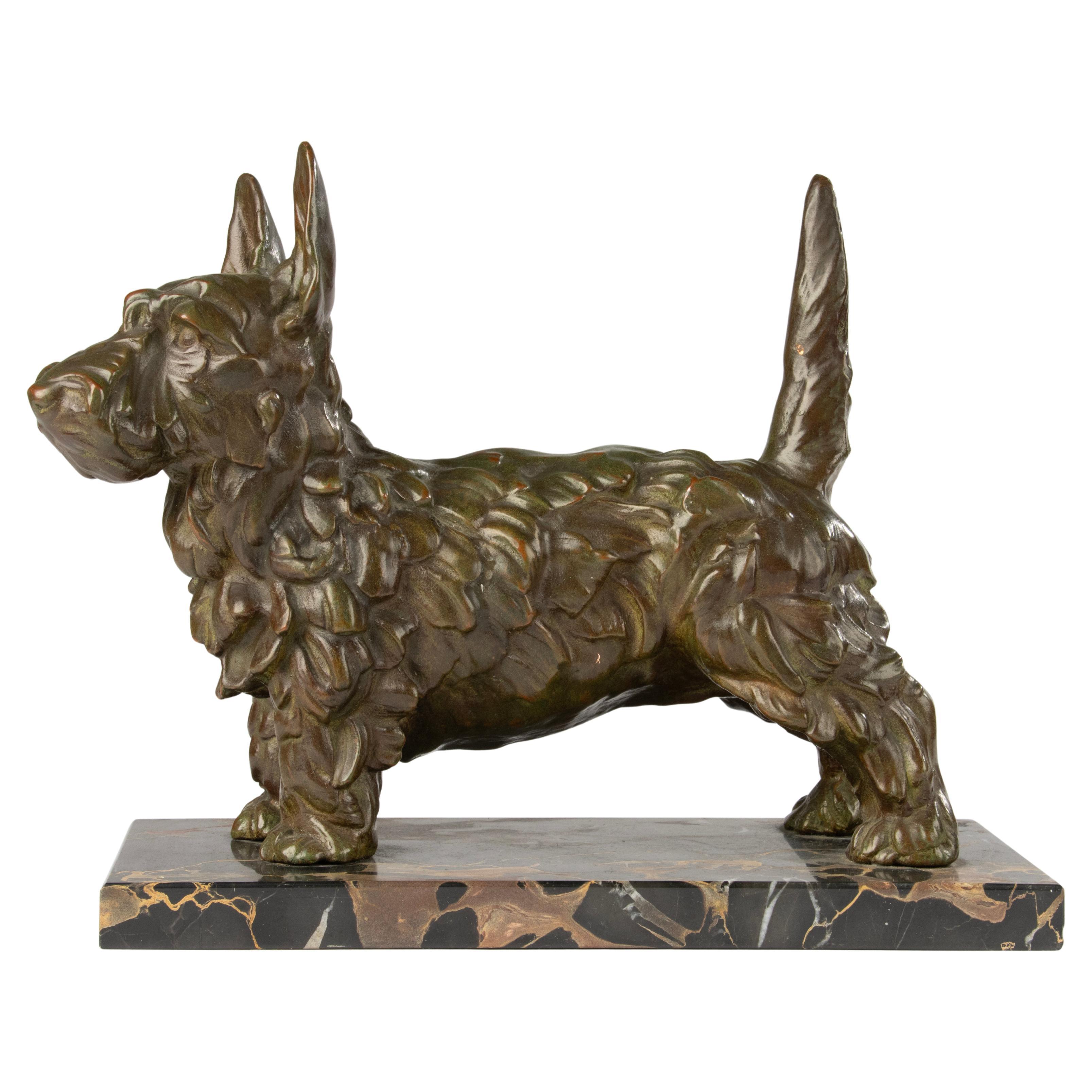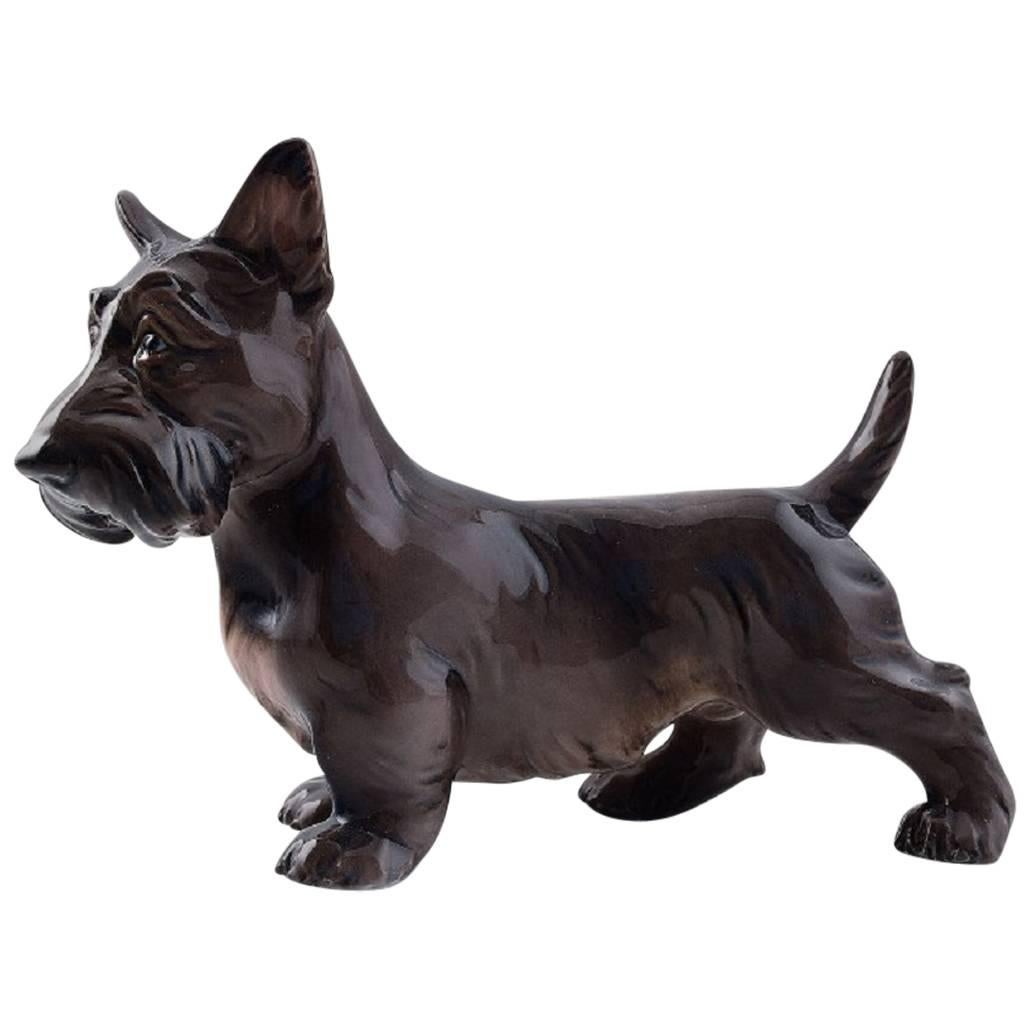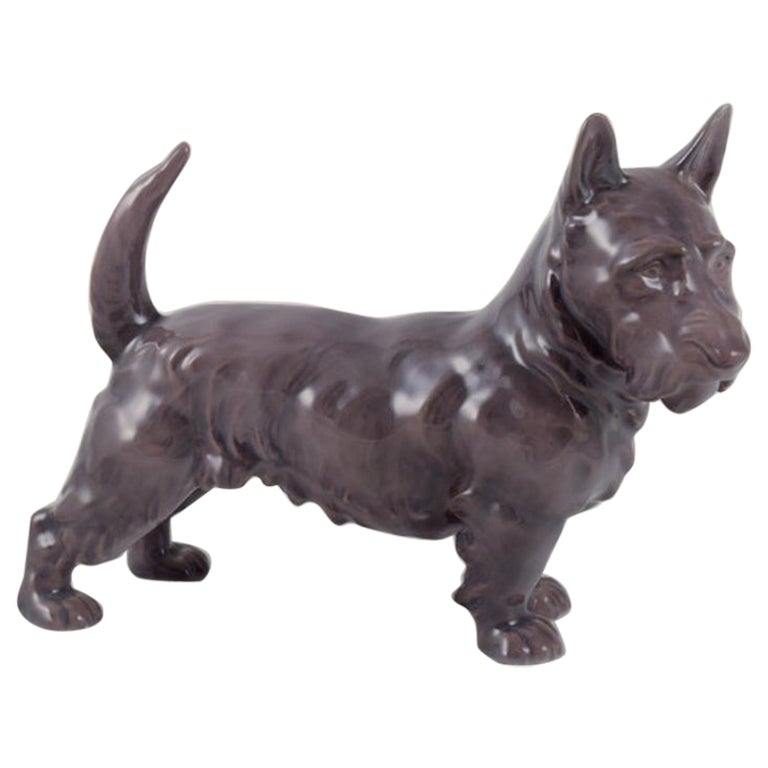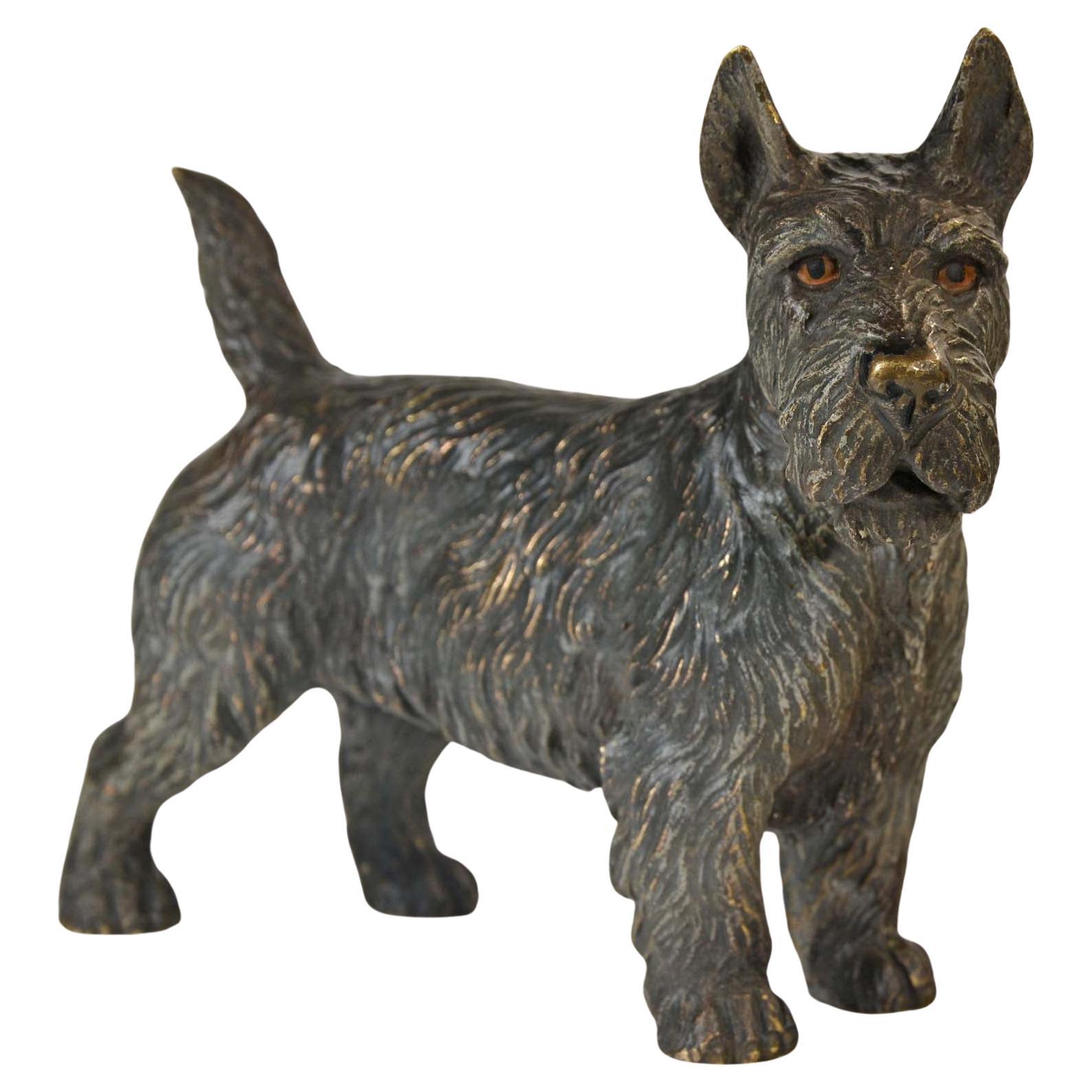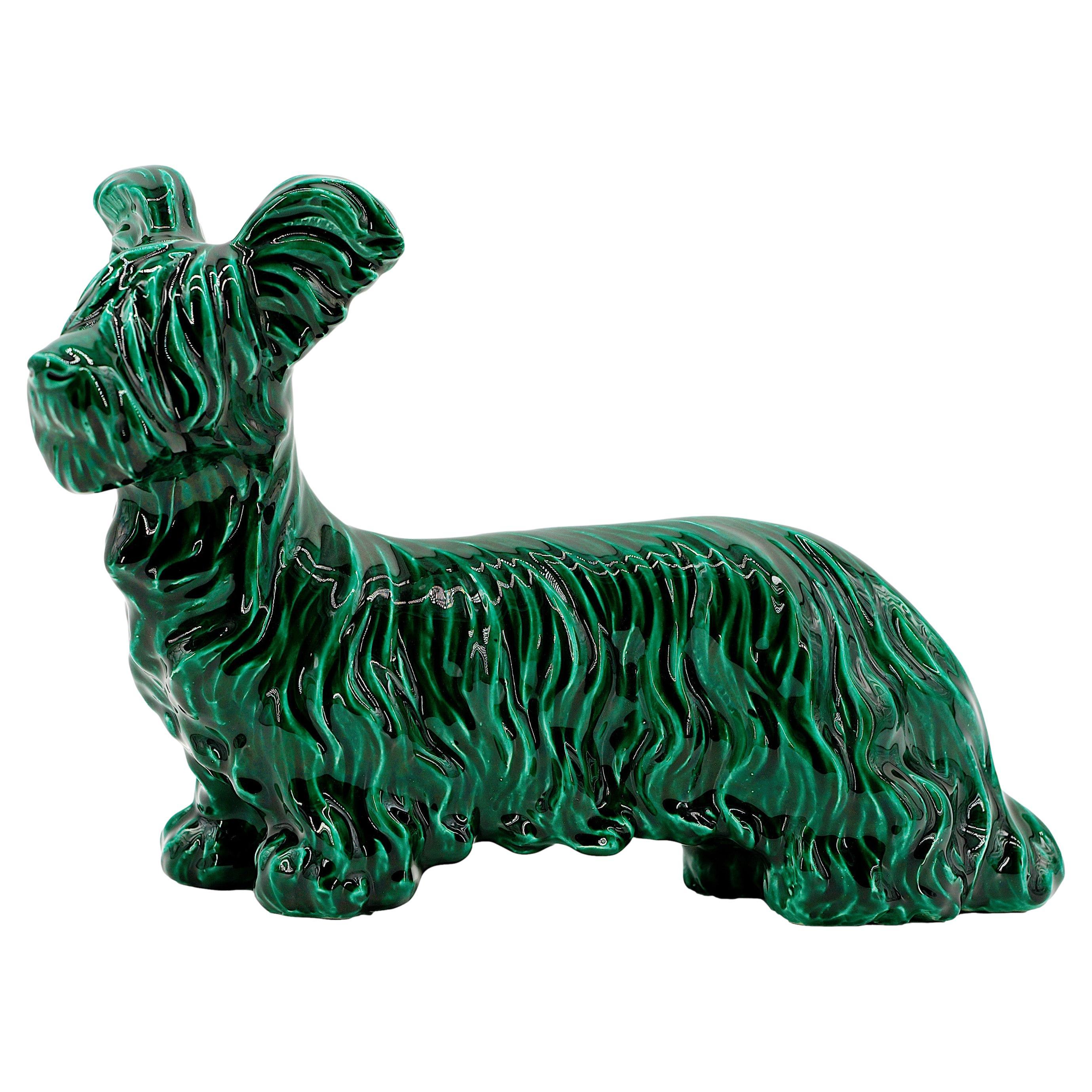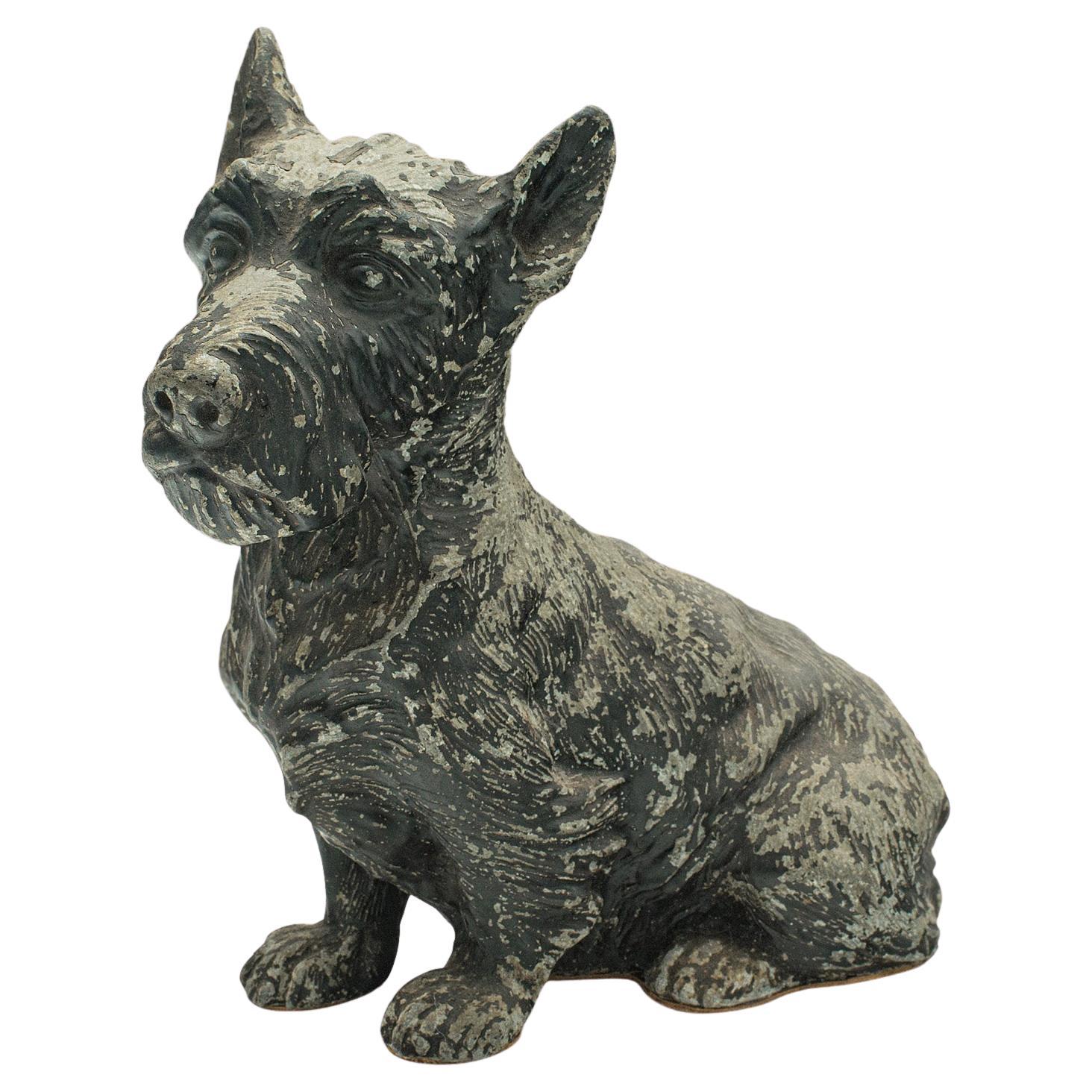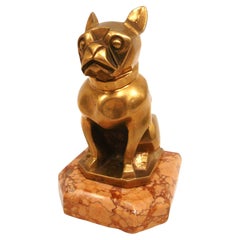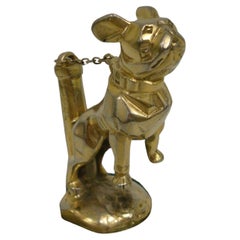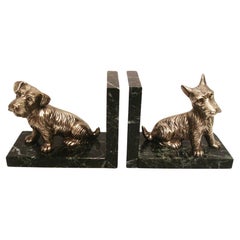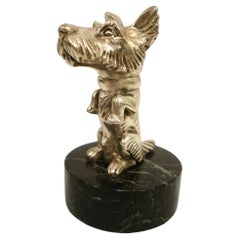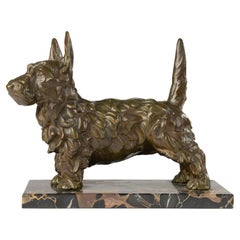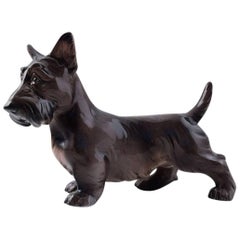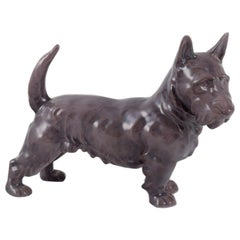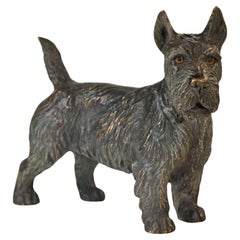Items Similar to Carl Auböck Style Scotch Terrier Art Deco Sculpture from the 1920s
Want more images or videos?
Request additional images or videos from the seller
1 of 11
Carl Auböck Style Scotch Terrier Art Deco Sculpture from the 1920s
$1,999
£1,538.54
€1,752.13
CA$2,841.87
A$3,089.21
CHF 1,619.02
MX$37,598.34
NOK 20,379.58
SEK 19,150.18
DKK 13,084.92
About the Item
Carl Auböck Style Scotch Terrier Art Deco Sculpture from the 1920s.
Rare Art Deco sculpture, displaying a lovely scotch terrier, made of black polished wood, on a brass base. Designed and executed in the style of Carl Aubock (1900- 1957), dated around 1928-1930. It has a total length of 14".
On the dog collar id says CARL , and the brass base is stamped AUSTRIA.
Carl Aubock in his early days as an artist, did a series of dogs figures, in the same style as this one. Only a very few of those sculptures have been made (less than 10 pieces). In excellent condition with nice patina.
Carl Aubock did work very similar to Hagenauer.
We have specialized in the sale of Art Deco and Art Nouveau and Vintage styles since 1995. If you have any questions we are at your disposal. Pushing the button that reads 'View All From Seller'. And you can see more objects to the style for sale. Why are there so many antiques in Argentina?
In the 1880 – 1940 there was a grate wave of immigration encouraged by the periods of war that were taking place. 1st World War took place between 1914 and 1918 2nd World War took place between 1939 and 1945 The immigrants options were New York or Buenos Aires. Tickets were cheap and in Buenos Aires they were welcomed with open arms, as it was a country where everything was still to be done. Argentina was the country of new opportunities, labour was needed and religious freedom was assured, in many cases the of the family travel first until they were settled and then the rest of the family members join them. In the immigrant museum “Ellis Island Immigrant Building” in New York you can se the promotional posters of the boats that would take them to a new life. Between the years 1895 and 1896, Argentina had the highest DGP (gross domestic product) per capita in the world according to the Maddison Historical Statistics index, this situation arose due to the large amount of food being exported to European countries, which were at war. The Argentinean ships left the port of Buenos Aires with food, but they returned with furniture, clothes and construction elements, (it´s common to see this the old buildings of the historic neighbourhood of San Telmo, the beams with the inscription “Made in England)”, as well as many markets that were built in Buenos Aires, such us the San Telmo Market, whose structure was brought by ship and afterwards assembled in 900 Defensa Street. With the great influence of European immigrants living in the country, the children of the upper classes travelled to study in France, resulting in the inauguration of “La Maison Argentinienne”, on 27th of June 1928, in the international city of Paris, which hosted many Argentinians that were studying in Frace. It´s the fourth house to be built after France, Canada and Belgium, being the first Spanish-speaking one. Still in place today (17 Bd Jourdan, 75014, Paris, France). Many of the children of these wealthy families who attended international art exhibitions, museums and art courses abroad, took a keen interest in the European style. This is why Buenos Aires was at the time referred as “The Paris of South America”. Between the years 1890 and 1920 more than a hundred Palaces were built on Alvear Avenue the most exclusive avenue in Buenos Aires. Today some of these palaces have been transformed into museums, hotels and embassies. In the year 1936, the Kavanagh building was inaugurated, it was the tallest reinforced concrete building in South America. During 1994 the American Society of Civil Engineers distinguished it as an “international engineering milestone”, and it´s now considered a World Heritage of Modern Architecture. At the time was common to hire foreign architects such as Le Corbusier, who visited Buenos Aires/Argentina in 1929 and in 1948 he drew up the blueprints for a house built in La Plata City (which was declared a World Heritage Site). In 1947, the Hungarian architect Marcelo Breuer designed “Parador Ariston” in the seaside city of Mar del Plata. After an Argentinean student at Harvard University convinced him to come to Argentina. He worked on an urban development project in the Casa Amarilla, area of La Boca. The Ukrainian architect, Vladimiro Acosta, arrives in Argentina in 1928 and worked as an architect until que moved to Brazil. Antonio Bonet, a Spanish architect who worked with Le Corbusier in Paris, arrives in Argentina in 1937, where he carried out several architectural works and in 1938 designs the well-known BFK chair. Andres Kálnay, of Hungarian origin, made around 120 architectural masterpieces, among which the former Munich brewery stands out, he even made the furniture’s design. The German architect, Walter Gropius, director of the Bauhaus, lived in Argentina, where he wrote articles for “Sur” magazine and founded in Buenos Aires, an architectural firm with Franz Möller, who was also an architect, where he built two houses. At the same time several famous designers decided to immigrate to Argentina, among them we can find the well-known French designer, Jean-Michel Frank, who arrived in the country in 1940 and also worked for the Rockefeller family. Special pieces were made, which were sold exclusively in the country, such as the well-known German company “WMF”, who sold their products by catalogue, which were chosen by the ladies of high society in the list of wedding gifts, as well as the pieces designed by Christofle. The Swiss sculptor Alberto Giacometti, made special pieces for Argentinean mansions. In 1904 the first Jansen branch outside Paris was established in Buenos Aires, as the Argentinean clientele demanded a large amount of furniture, from the end of the 19th century to the mid-20th century. In 1970, the brand Rigolleau Argentina made pieces authorised by Lalique. The brands Maple and Thompson also set up shop in the country. The French plastic artist, Marcel Duchamp moved to Argentina in 1918-1919. Glass signed Gallé, Charder, Leverre, Schneider, Muller and other French firms. They were bought in flower shops and were given to ladies with beautiful floral arrangements. Some furniture manufacturers travelled to international fairs and bough the patterns to produce the furniture in Argentina, such as the furniture firm Englander and Bonta, who bought the patterns in Italy. It is worth mentioning that in Argentina we have the largest community of Italians outside of Italy, as it is estimated that 70 percent of the inhabitants have at least one Italian descendant, followed by Spanish immigrants. The most Important furniture stores in Argentina: Comte is founded in 1934 (under the direct management of Jean Michel Frank in 1940). Nordiska (Swedish company established in 1934). Churba in 1960, a company that brought foreign designers to present their furniture in the country: Denmark: (Arne Jacobsen, Finn Juhl, Bender Madsen, Ejner Larsen, Poul Kjaerholm, Hans Wegner) Sweden: (Hans Agne Jakobsson, Gustavsberg) United States: (Herman Miller) Finland: (Lisa Johansson, Folke Arstrom, Tapio Wirkkala, Alvar Aalto, Timo Sarpaneva) Swedish Factory: (Orrefors) Italy: (Littala, Vico Magistretti, Emma Gismondi, Gae Aulenti, Angelo Mangiarotti, Elio Martinelli, Gianna Celada, Angelo Mangiarotti, Mario Bellini, Carlo Scarpa) Finland: (Olivia Toikka) Plata Lappas (Lappas Silver): a goldsmith shop founded in 1887 in Argentina by Alcibiades Lappas of Greek origin. In 2019, in Argentina took place “the Art Deco world congress” . Argentina currently has more than 100 Art Deco buildings and another 90 Art Nouveau buildings throughout the city of Buenos Aires. Argentina is a country that has not been involved in many wars, which is why it has been a refuge for works of art and antiques from different periods of time, unlike European countries. That is way many collectors, museums and antique dealers from all over the world visit it, you should not miss the opportunity to visit this great country.
- Similar to:Werkstätte Carl Auböck (Artist)
- Dimensions:Height: 8.47 in (21.5 cm)Width: 13.78 in (35 cm)Depth: 1.97 in (5 cm)
- Style:Art Deco (In the Style Of)
- Materials and Techniques:
- Place of Origin:
- Period:
- Date of Manufacture:1920´s
- Condition:Refinished. Wear consistent with age and use. Sculpture has been polished.
- Seller Location:Buenos Aires, AR
- Reference Number:1stDibs: LU2027342118732
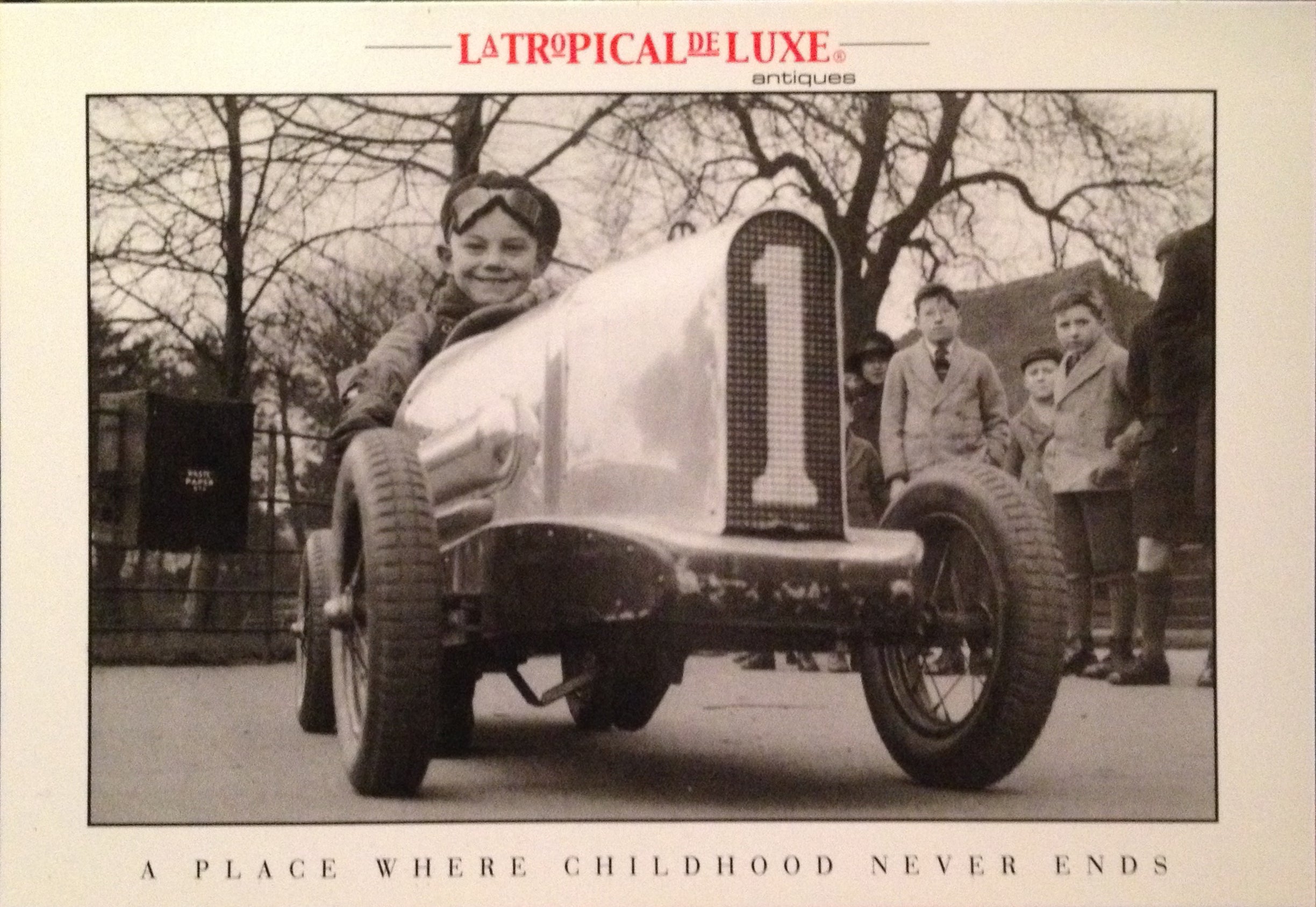
About the Seller
4.9
Vetted Professional Seller
Every seller passes strict standards for authenticity and reliability
Established in 2002
1stDibs seller since 2016
327 sales on 1stDibs
Typical response time: <1 hour
- ShippingRetrieving quote...Shipping from: Buenos Aires, Argentina
- Return Policy
Authenticity Guarantee
In the unlikely event there’s an issue with an item’s authenticity, contact us within 1 year for a full refund. DetailsMoney-Back Guarantee
If your item is not as described, is damaged in transit, or does not arrive, contact us within 7 days for a full refund. Details24-Hour Cancellation
You have a 24-hour grace period in which to reconsider your purchase, with no questions asked.Vetted Professional Sellers
Our world-class sellers must adhere to strict standards for service and quality, maintaining the integrity of our listings.Price-Match Guarantee
If you find that a seller listed the same item for a lower price elsewhere, we’ll match it.Trusted Global Delivery
Our best-in-class carrier network provides specialized shipping options worldwide, including custom delivery.More From This Seller
View AllArt Deco Sculpture of a French Bulldog Bookend or Paperweight, France, 1920s
Located in Buenos Aires, Olivos
Art Deco or Cubist Bronze sculpture of a French bulldog bookend or paperweight.
Made of bronze, mounted over a marble base.
Made in France, 19...
Category
Vintage 1920s French Art Deco Paperweights
Materials
Marble, Bronze
Art Deco Car Mascot, Chained French Bulldog, Hood Ornament, France 1920s
Located in Buenos Aires, Olivos
Art Deco 'Chained Bulldog' Car Mascot / Hood Ornament designed by Marvel, French, 1920´s, silver-Gilt plated bronze, small version, 14cm long, compl...
Category
Vintage 1920s French Art Deco Animal Sculptures
Materials
Bronze
Art Deco Silvered Bronze Bookends featuring Scottish Terriers Dogs
Located in Buenos Aires, Olivos
This is a set of Art Deco bookends featuring Scottish Terriers. The Scottie is very detailed and the silvered bronze patina is a great. The base is a dark green marble that just makes those dogs "pop".
Wonderful cast silvered Bronze scottie dog bookends...
Category
Vintage 1920s English Art Deco Animal Sculptures
Materials
Belgian Black Marble, Bronze
Vintage Terrier Silvered Sculpture / Figure / Desk Paperweight. c1930´s
Located in Buenos Aires, Olivos
Midcentury small silvered metallic sculpture of a dog, likely a terrier breed, standing on its hind legs with its front paws raised. The dog is detailed with fur texture and facial f...
Category
Mid-20th Century French Mid-Century Modern Animal Sculptures
Materials
Marble, Metal
Art Deco Hermès Paris "Ric et Rac" Dogs Car Mascot / Hood Ornament. Pol Rab 1920
By Hermès, Pol Rab
Located in Buenos Aires, Olivos
Art Deco Hermès Paris "Ric et Rac" Dogs Car Mascot / Hood Ornament. Pol Rab 1920´s.
Pol RAB (1898-1933) "Ric et Rac"
Car Mascot by Pol Rab, exclusive For Hermès, Circa 1920s. Marked "Hermès Paris" and artist signature Pol Rab. Inspired by the artist's cartoons published in the newspaper "Le Rire" at the end of the 20´s. Silvered bronze. Mounted on a marble base. The medals on the dog´s collars say Ric & Rac.
Perfect Gift for any vintage & antique car fan, any automobilia collector.
Car be used as a desk paperweight.
The Bronze hood ornament measures 10 cm aprox 10 inch. including the base it measures 13.5 cm.
Pol Rab – Creator of Ric and Rac...
Category
Early 20th Century French Art Deco Animal Sculptures
Materials
Marble, Bronze
German Shepherd Dog Sculpture Bookends by Louis-Albert Carvin. France 1925
By Louis-Albert Carvin
Located in Buenos Aires, Olivos
German Shepherd dog sculpture bookends by Louis-Albert Carvin.
Dog Animalier Art Deco Sculpture Bookends in Marble and Silvered Metal. Pair of large Silvered Metal Sculptures of two ...
Category
Early 20th Century French Art Deco Bookends
Materials
Marble, Metal
You May Also Like
Antique Bronze Sculpture of a Scottie Dog - Early 20th Century
Located in Casteren, Noord-Brabant
A lovely bronze animal sculpture. This charming bronze sculpture depicts a characterful terrier, most likely a Scottish Terrier, captured in an alert and proud stance.
Crafted in the...
Category
Vintage 1920s French Art Deco Animal Sculptures
Materials
Marble, Bronze
Dahl Jensen Number 1066, Scottish Terrier Standing, DJ
Located in København, Copenhagen
Dahl Jensen number 1066, Scottish Terrier standing (DJ).
Measures 17 cm.
Marked with Royal Crown and DJ Copenhagen.
2. factory quality, in good condition.
Category
20th Century Danish Scandinavian Modern Porcelain
$280 Sale Price
20% Off
Bing & Grøndahl, porcelain figurine of a Scottish Terrier. 1930s
Located in København, Copenhagen
Bing & Grøndahl, porcelain figurine of a Scottish Terrier.
Model number 2117.
Approximately from the 1930s.
Marked.
Second factory quality. Minimal glaze bubbles on the back of the l...
Category
Vintage 1930s Danish Animal Sculptures
Materials
Porcelain
Austrian cold painted bronze of a Scottish Terrier, or 'Scottie Dog'
Located in Castle Douglas, GB
Austrian cold painted bronze of a Scottish Terrier, or 'Scottie Dog'. Fine naturalistic colours and good hand chased surface detail. Stamped 'AUSTRIA'. A very well preserved example...
Category
Early 20th Century Austrian Animal Sculptures
Materials
Bronze
Santiago Rodriguez Bonome Ceramic Skye Terrier Sculpture
By Santiago Rodríguez Bonome 1
Located in Saint-Amans-des-Cots, FR
French Art Deco ceramic skye terrier sculpture by Santiago Rodriguez Bonome, France, 1920s. Height: 9.65"(24.5cm) , Width: 14.2"(36cm), Depth: 5.1"(13cm). Inciseded signature "SR BONOME PARIS" under the belly (see photo).
Many works are exhibited in different museums:
Paris, National Museum of Modern Art - National Center of Art and Culture Georges-Pompidou
La Rochelle
Spain, Valle-Inclan Foundation
Spain, Museum of Lugo
Spain, Caixanova Collection...
Spain, Prado Museum in Madrid
Born in Santiago de Compostela (Spain) in 1901, son of Evaristo Rodriguez Bréa and Antonia Bonome Pérez, he worked very young in his father's humble cabinetmaking workshop. Little attracted by this job, when his father asks him what he wants to do: "sculptor" he answers.
He therefore entered, at the age of 13, in the religious imagery workshop of José Rivas, at the foot of this cathedral which he admired so much, then at the age of 18 in that of Enrique Carballido.
"Because he is so, so young, Bonome! Ridiculously young said a critic, who probably did not know that these years of apprenticeship, of real apprenticeship as an apprentice in a real workshop (a saint a day and strongly, for all the processions, all the chapels and all the devotees of the province) are each worth four years -at least- of study in an academy..." Margarita Nelken (Madrid 1932)
In 1924, he left for Madrid where he exhibited at the Galician Center, at the National Exhibition and then in La Coruña.
In 1925, at the Galicia Center in Buenos Aires he sold almost 30 of his works.
From 1926 to 1927 he exhibited in Barcelona, at the Venice Biennale then in Monza (Italy) where he met Pirandello, then in Havana.
In 1929 he arrived in Paris where Lucas Moreno...
Category
Vintage 1920s French Art Deco Animal Sculptures
Materials
Ceramic
Antique Decorative Scottish Terrier Figure, British, Spelter, Dog, Edwardian
Located in Hele, Devon, GB
This is an antique decorative Scottish Terrier. A British, spelter ornamental Scottie dog, dating to the Edwardian period, circa 1910.
Exudes character and appealing weathering
...
Category
Early 20th Century British Edwardian Animal Sculptures
Materials
Spelter
More Ways To Browse
Deco Terrier
Art Deco Seal
Austrian Bronze Cats
Belgian Horse
Flying Horse
French 19th Century Wooden Horse
French Wood Carved Animals
Horns On Base
Hubley Cast Iron
Italian Ceramic Statue
Italian Murano Glass Swan Sculpture
Jere Sculpture Birds
Knud Kyhn Bear
Large Dog Sculptures
Large Monkey
Mexican Horse
Mid Century Seagulls
Monkey German
